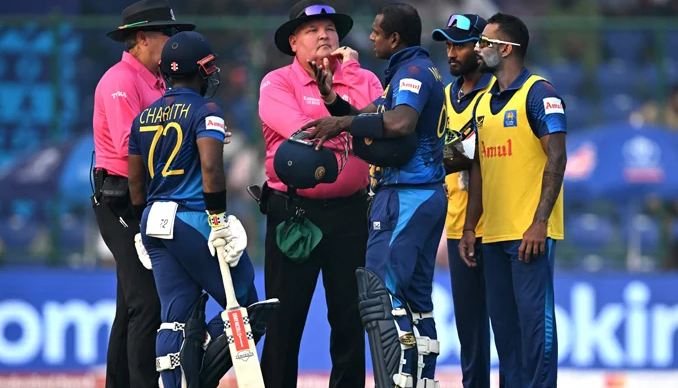In a groundbreaking moment during the ICC World Cup 2023, Angelo Mathews etched his name in cricket history as the first-ever batter to be timed out in international cricket. The incident took place during a riveting clash between Sri Lanka and Bangladesh in the heart of Delhi. Mathews’s untimely exit added an unexpected twist to the match that had fans on the edge of their seats.
When a batter is dismissed in cricket, the regulations state that the incoming batsman must be ready to face a ball within two minutes of the fall of a wicket. However, Mathews found himself in an unusual predicament. Just as he was about to take his stance, disaster struck when the strap of his helmet snapped. A frantic scramble ensued as Mathews urgently sought a replacement helmet. It was during this interlude that Shakib, the Bangladeshi captain, seized the opportunity to appeal to the umpires, ultimately leading to the unprecedented ruling of Mathews being timed out.
The incident sent shockwaves through the cricketing world, sparking debates and discussions on the validity and fairness of the ruling. The timing of Mathews’s exit was indeed a rare and perplexing moment in international cricket.
Smog-Enshrouded Delhi Hosts a Historic Match
Prior to this dramatic cricketing event, the backdrop of the match itself was nothing short of historic. Delhi, the host city for the Bangladesh-Sri Lanka Cricket World Cup match, had been grappling with severe air pollution. In a peculiar twist of fate, this smog-choked metropolis had the distinction of being ranked as the planet’s most polluted major city.
Delhi’s air quality had fluctuated between “poor” and “severe” in the days leading up to the match. With a staggering population of 30 million, the city had been under the watchful eye of environmentalists and health officials.
The severity of the air quality crisis was so palpable that some players and coaches from both teams had resorted to training with face masks in the days preceding the match. The polluted atmosphere had forced the cancellation of practice sessions, particularly affecting Bangladesh players who suffered from asthma and had to remain confined to their hotel rooms.
As the Sri Lanka innings got underway, alarming levels of PM2.5 particles, notorious for their ability to enter the bloodstream, were recorded at a staggering 184 micrograms per cubic meter, as per data from IQAir. This figure was over 12 times the daily maximum recommended by the World Health Organization.
In a stark revelation, a Swiss-based international monitoring company had declared Delhi as the world’s most polluted major city on that very day. The city’s dubious distinction served as a grim reminder of the ongoing environmental crisis that has become inextricably linked with the Indian capital.
Cricket vs. Environmental Concerns
Cricket is a sport that has often weathered various challenges, including unfavorable weather conditions. According to the International Cricket Council (ICC) guidelines, air quality is typically assessed and treated as a factor similar to weather conditions. The decision regarding the match’s continuation or postponement ultimately rests with match officials who consider the welfare of the players and the feasibility of conducting the game under the prevailing circumstances.
Notably, this was not the first instance of severe pollution affecting a cricket match in Delhi. In December 2017, during a Test match, Sri Lankan players had been compelled to don masks to shield themselves from the toxic air. The pollution levels had soared to such heights that even Indian bowler Mohammed Shami had succumbed to the conditions, vomiting on the pitch.
The incident involving Angelo Mathews and the backdrop of environmental concerns have further fueled the debate about the intersection of sports and environmental responsibility. The world of cricket is now left to grapple with the question of how to ensure the well-being of its athletes while adapting to the ever-evolving challenges posed by our environment.
This historic match in Delhi will undoubtedly be remembered not only for the cricketing drama it brought but also for the environmental concerns that loomed large over the proceedings. As the cricketing world continues to evolve, it remains to be seen how it will address and navigate these pressing issues in the future.












